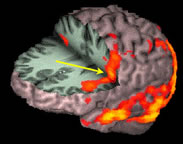Super Bowl Ads: GoDaddy Girl 1, Neuroscientists 0
 Shortly after the big game (and big advertising extravaganza), we reported on some interesting, if not highly scientific, research in Super Bowl Ads Meet Brain Scans. The experiment, in which neuroscientists measured brain activity using fMRI (functional magnetic resonance imaging) equipment is described in detail in an article by researcher Marco Iacoboni: Who Really Won the Superbowl? Some bloggers found the experiment of dubious value. Sandra of the Neurofuture blog sums up some of the questions. Vaughan of the MindHacks blog is also skeptical, noting
Shortly after the big game (and big advertising extravaganza), we reported on some interesting, if not highly scientific, research in Super Bowl Ads Meet Brain Scans. The experiment, in which neuroscientists measured brain activity using fMRI (functional magnetic resonance imaging) equipment is described in detail in an article by researcher Marco Iacoboni: Who Really Won the Superbowl? Some bloggers found the experiment of dubious value. Sandra of the Neurofuture blog sums up some of the questions. Vaughan of the MindHacks blog is also skeptical, noting
The difficulty is that the functions of these areas are still controversial. For example, with the Super Bowl ads, Iacobini claims that activation in the ‘mirror system’ is a measure of empathy. This is still highly contentious and is presumably based on conclusions from an earlier study of his. Because of this uncertainty, it is difficult to know that any difference is not due to one advert having more movement in it than the other. Or perhaps more people. Or happier people. Or even something unrelated like a faster tempo in the music… despite the advert being otherwise rubbish.
Martin Skov of the BrainEthics blog notes,
I don’t feel, however, that any neuromarketing experiment at the moment will be able to tell an ad agency anything really important. Our knowledge of how the brain’s preference system works is simply to rudimentary. The way Iacoboni claims he can see activity in his subjects’ brains which are at odds with their overt reports must be treated with the utmost skepsis. Even if some ad actually elicits a high response in the reward system this activity may not, simply, correlate with a clear-cut preference for the ad.
I do think these skeptical comments are sensible. The criticisms don’t dispute that a better understanding of our brain’s reactions to ads can’t help marketers do a better job, but rather that we currently lack the knowledge to relate what we see going on in the brain to what makes an ad effective. Indeed, not all ads have the same goal – one advertiser might be seeking to establish an aura of prestige around their product, another might want to convince you that their product technology lets it perform better than similar products, and yet another may be seeking only to create name recognition for a new brand.
It’s easy to imagine that a “warm & fuzzy” ad like Budweiser’s pony who wants to pull the wagon will activated different brain areas than CareerBuilder.com’s chimps in the workplace or Pizza Hut’s sultry Jessica Simpson spot. These ads are all pulling different emotional (and occasionally rational) strings, and one would expect different types of brain activity.
The truth is that at the moment, we don’t really know what all that brain activity means. That doesn’t mean the experiments are a bad idea – it just means that we need to keep working to establish a correlation between the brain effects of the advertisement and the ultimate achievement of the advertiser’s objectives. Of course, measuring ad effectiveness can be difficult even using conventional techniques. If Budweiser sales are up 5% in February, does that mean their Superbowl ads worked? If so, which individual ads had the biggest impact on consumer behavior? Teasing out this kind of information is next to impossible. Certainly, viewers can be surveyed to see which ads they liked, which ones they remembered, whether they associate the ad with the company that ran it, and so on. However, relating an individual ad to what the consumer does in the supermarket aisle a month later just can’t be done. Brain science can, at least, provide some data on the effects of different ads on real people. As we get better at interpreting this data, fMRI and other neuromarketing techniques will be used more and relied on more.
 So how well DID the Superbowl Ad brain scans predict the real life winners? To date, I’ve only seen one hard data point on consumer behavior (not ad recall, like/dislike, etc., but actual behavior): Comscore reported on actual website traffic during the SuperBowl, comparing the number of website visits for each advertiser in real time. They declared GoDaddy.com, whose ad featured a well-endowed model experiencing yet another wardrobe malfunction, to be the big winner. GoDaddy’s site traffic was up 1500%, and they attracted 439,000 unique visitors. The second biggest gainer was Budweiser, who saw a 500% increase in traffic but ran a much larger number of spots than GoDaddy. The brain scan verdict on the GoDaddy ad? After studying the brain scans, Iacoboni called it one of the “three biggest flops” of the Super Bowl. Score one for the GoDaddy Girl.
So how well DID the Superbowl Ad brain scans predict the real life winners? To date, I’ve only seen one hard data point on consumer behavior (not ad recall, like/dislike, etc., but actual behavior): Comscore reported on actual website traffic during the SuperBowl, comparing the number of website visits for each advertiser in real time. They declared GoDaddy.com, whose ad featured a well-endowed model experiencing yet another wardrobe malfunction, to be the big winner. GoDaddy’s site traffic was up 1500%, and they attracted 439,000 unique visitors. The second biggest gainer was Budweiser, who saw a 500% increase in traffic but ran a much larger number of spots than GoDaddy. The brain scan verdict on the GoDaddy ad? After studying the brain scans, Iacoboni called it one of the “three biggest flops” of the Super Bowl. Score one for the GoDaddy Girl.
Does this mean neuroscience can’t inform marketers? Not in the least… we just need a better understanding of the neuroscience involved, of how observed brain activity correlates with later behavior, and of how neuromarketing techniques fit into the marketing toolbox with the great variety of conventional research tools.
